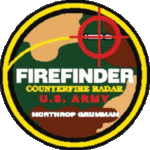
PE & SSN #: BZ7325 - FIREFINDER, ELECTRONICS UPGRADE, ENHANCED FIREFINDER, ATG MOBILITY IMPROVEMENT.
654270/DL18, VA8000 SHORTSTOP
644823/DL85, BA5100 FIREFINDER P3I
DESCRIPTION: FIREFINDER is comprised of the AN/TPQ-36 and AN/TPQ-37 Mortar and Artillery Locating Radars. The AN/TPQ-36 H fielded to both the Army and Marine Corps. These radars are organic to separate infantry and armor brigades, to the Target Acquisition Battery (TAB) at Division Artillery (Div Arty), and/or Corps Target Acquisition Detachments. FIREFINDER radars are currently operational and are used in all military operations to include Operation Desert Shield/Storm and the Implementation Force (IFOR) in Bosnia.
HISTORICAL BACKGROUND: Fielding and deployment of the AN/TPQ-36 and AN/TPQ-37 Radars is complete. Operational use and sustainment of fielded FIREFINDER continues.
PRODUCT IMPROVEMENTS TO FIREFINDER SYSTEMS: Several Materiel Changes/Product Improvements are in process.
AN/TPQ-36 MATERIEL CHANGES (MC):
AN/TPQ-36(V)8 Electronics Upgrade. This MC will improve the Operations Control Group (OCG), now called the Operations Central (OC), through the installation of state-of-the-art electronics including Common Hardware/Software (CHS) Lightweight Computer Unit Version 2 (LCU V2) equipment in the Lightweight Multipurpose Shelter (LMS). The upgrade is an open architecture design and will allow FIREFINDER to communicate on the digitized battlefield. The OC will also incorporate an Environmental Control Unit (ECU) and a Gas Particulate Filter Unit (GPFU). Major subsystems of the OC include an Operator Control Station (OCS), a Control/Display Terminal (CDT) and a radar processor. The OCS will serve as the man-machine interface and is a modern windows type display. Using the CDT, the operator will be able to control system operations from a site up to 100 meters remote from the shelter. The radar processor will perform all systems processing functions not assigned to the OCS. It will be reprogramable and reconfigurable to maximize system performance under varying target and operating environment conditions. The new OCG will enhance the man-machine interfaces and electronics environment by providing 50 percent more interior space and improved environmental control. A full scale production contract was awarded in Aug 96 after a successful MS III Decision in Jun 96.
AN/TPQ-37 MATERIEL CHANGES (MC):
1. Antenna Transceiver Group (ATG) Mobility Improvement. This MC will improve the mobility of the AN/TPQ-37(V) ATG in sand, mud, and soft earth by applying a tracked suspension system to the M-1048 trailer. This will reduce ground contact pressure and drawbar pull force, and eliminate tire wear problems.
2. Enhanced FIREFINDER Block I. This MC upgrades mechanical deficiencies, incorporates improvements in the software, reduces the number of false locations, improves the reliability of the transmitter, increases the organic capability of C-130/C-141 transportability, and improves the survivability against ARMS. The software improvements will be provided to Ft. Sill Software Engineering Directorate for incorporation and testing in the Version 11 update to the FIREFINDER system software. Two preproduction survivability suites developed during Enhanced FIREFINDER Block I will be put into contingency storage.
3. FIREFINDER P3I. The FIREFINDER P3I program will improve performance of the AN/TPQ-37 by replacing the Antenna Transceiver Group (ATG). This is in response to the approved MNS for the Advanced FIREFINDER System and an approved ORD dated Sep 96. The new ATG will double the detection ranges of all targets, add a Tactical Ballistic Missile detection capability, increase the target throughput tenfold, increase mobility and transportability by C-130, and decrease the crew requirements from twelve (12) to nine (9). The program will leverage off the funded AN/TPQ-36(V)8 Electronics Upgrade program which will provide a common man-machine interface.


